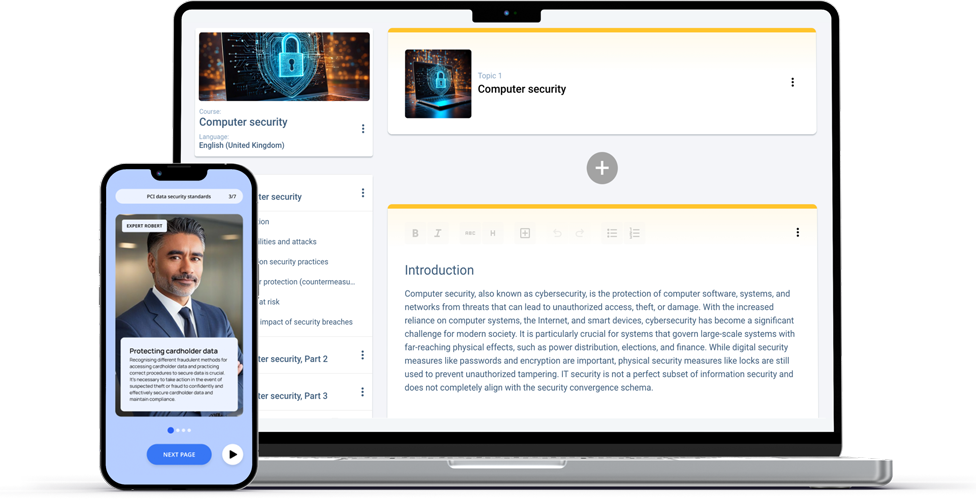What is an L&D budget? Definition, purpose and challenges
We’ll explore learning and development budgets, focusing on their purpose and role in aligning training with organisational goals. This understanding is crucial for navigating the challenges and maximising the impact of L&D efforts.
The average learning and development training budget is a critical factor that varies by company size, highlighting how much large, mid-size, and small companies allocate for training expenses.
A working definition of an L&D budget
An L&D (Learning and Development) budget is a targeted allocation of funds specifically earmarked for enhancing the knowledge, skills, and competencies of an organisation’s workforce through systematic training and development initiatives. This budget is a strategic component of an organisation’s broader financial planning, covering costs related to various aspects of learning and development programs.
Training costs include hiring trainers, buying or creating course materials, and LMS licensing fees. Other expenses are less obvious. These include the opportunity cost of training time versus working, administrative time for organising training, and a temporary drop in productivity as employees learn new skills or technologies. The average employee salary can serve as a basis for estimating training costs by multiplying it with the number of full-time equivalents (FTEs).
Accurate cost estimates are crucial for predicting training expenses based on detailed analyses of past experiences and planned initiatives.
The purpose of an L&D budget plan

A well-crafted L&D budget plan is not just a financial document - it’s a strategic tool serving many functions. These include but are not limited to the following:
- Resource allocation: Provides a clear roadmap for allocating financial resources across various training needs. Learning and development programs play a crucial role in this process, ensuring that resources are effectively used to enhance workforce skills and competencies.
- Financial discipline and accountability: Instills a sense of financial discipline by setting clear boundaries on how to spend learning and development budget. It also promotes accountability among those responsible for implementing learning programs, as they must work within the allocated training budget to achieve desired learning outcomes.
- Measuring training ROI: Facilitates measuring return on investment for training initiatives. By setting clear financial parameters, organisations can evaluate the effectiveness of their L&D efforts in terms of improved performance, productivity, and other relevant metrics, adjusting their strategies accordingly.
- Demonstrating commitment to employees' development: Underscores an organisation’s commitment to its employees’ growth and development. A high learning and development budget per employee can significantly boost their engagement, morale, and retention, as it clearly communicates the value placed on personal and professional development.
- Adaptability to change: Enables organisations to quickly respond to industry changes or internal shifts by reallocating resources to areas of immediate need, ensuring the workforce remains relevant and competitive.
- Crisis resilience: Prepares organisations to weather economic downturns or unexpected events by prioritising essential training that maintains operational effectiveness and employee morale.
Importance of aligning L&D budget with business goals
Aligning your L&D budget with business goals is not just a best practice; it’s a strategic necessity. When your learning and development initiatives are directly tied to your company’s strategic objectives, the impact is profound and multifaceted. This alignment ensures that every dollar spent on training and development is a step towards achieving broader business goals, making it easier to demonstrate the value of L&D to business leaders and stakeholders.
By aligning your L&D budget with business goals, you can:
- Improve employee performance and productivity: Targeted training programs that address specific business needs can significantly enhance employee capabilities, leading to better performance and higher productivity.
- Enhance customer satisfaction and loyalty: Well-trained employees are better equipped to meet customer needs, leading to improved customer experiences and increased loyalty.
- Increase revenue and profitability: Effective training initiatives can drive business growth by improving operational efficiency and enabling employees to contribute more effectively to revenue-generating activities.
- Stay competitive in the market: Continuous learning and development keep your workforce agile and adaptable, ensuring your organisation remains competitive in a rapidly changing market.
- Achieve strategic objectives: When L&D efforts are aligned with business goals, they directly contribute to the achievement of strategic objectives, making it easier to track progress and demonstrate success.
To align your L&D budget with business goals, consider the following steps:
- Conduct a thorough analysis of business objectives and goals: Understand the strategic direction of your organisation and identify the skills and knowledge required to achieve these goals.
- Identify the skills and knowledge gaps: Determine where your workforce currently stands in terms of skills and competencies and identify the gaps that need to be addressed.
- Develop a comprehensive L&D strategy: Create a strategy that aligns with your business goals, outlining the training initiatives and programs needed to bridge the identified gaps.
- Allocate budget and resources accordingly: Ensure that your L&D budget is allocated in a way that supports the strategic objectives of your organisation.
- Monitor and evaluate the impact: Regularly assess the effectiveness of your L&D initiatives in achieving business goals and make adjustments as needed.
Overview of common challenges in managing L&D budgets
While L&D budgets are fundamentally beneficial, managing them effectively does pose some challenges.
- Justifying investment: Companies spend significant amounts on L&D, and demonstrating the ROI of these activities to stakeholders and business leaders often demands clear, measurable outcomes, which can be challenging to quantify.
- Allocating funds: Deciding how to allocate limited funds across various L&D initiatives to maximise impact involves difficult trade-offs and strategic decision-making.
- Adapting to change: The rapid pace of technological evolution and shifting learning and development trends can render existing L&D programs obsolete, necessitating ongoing adjustments to the budget.
- Complexity in budget estimation: Determining the optimal size of an L&D budget requires understanding both current and future training needs, a task complicated by the dynamic nature of business and technology.
- Oversight of indirect expenses: Tracking both direct and indirect costs associated with training programs is essential for budget management but can be challenging, especially quantifying indirect costs like employee downtime and loss of productivity during training.
- Handling unexpected costs: Unexpected costs, such as the sudden need for specialised training due to regulatory changes or technological updates, can strain the L&D budget, requiring the reallocation of funds or seeking additional resources.
This foundational understanding sets the stage for delving deeper into practical strategies that will enable you to leverage tailored L&D budget solutions to foster continuous improvement and strategic development.








